. 2015. “AERobot: An Affordable One-Robot-Per-Student System for Early Robotics Education.” In Intl. Conference on Robotics and Automation (ICRA). (pdf)
Search
Search results
. 2015. “Towards Self-assembled Structures with Mobile Climbing Robots.” In Intl. Conference on Robotics and Automation (ICRA). (pdf)
. 2015. “Arrestant property of recently manipulated soil on Macrotermes michaelseni as determined through visual tracking and automatic labeling of individual termite behaviors.” Behavioural Processes, 116, Pp. 8-11. Publisher's Version
. 2015. “Seaturtle: A low-cost underwater Robot.” ES100 Senior Capstone Project. (pdf)
. 2014. “Task Allocation in Ant Colonies.” In Intl. Symposium on Distributed Computing (DISC). (pdf)Abstract
. 2014. “Collective Construction by Termite-Inspired Robots.” Doctoral Thesis, Harvard University. (pdf)
. 2014. “Towards Self-Assembled Structures with Mobile Climbing Robots.” Master's Thesis, EPFL. (pdf)
. 2014. “Programmable self-assembly in a thousand-robot swarm.” Science, 345, 6198.Abstract
. 2014. “Distributed Range-Based Relative Localization of Robot Swarms.” In Intl. Workshop on the Algorithmic Foundations of Robotics (WAFR). (pdf)
. 2014. “Autonomous MAV guidance with a lightweight omnidirectional vision sensor.” In IEEE Intl. Conf on Robotics and Automation (ICRA). (pdf)
